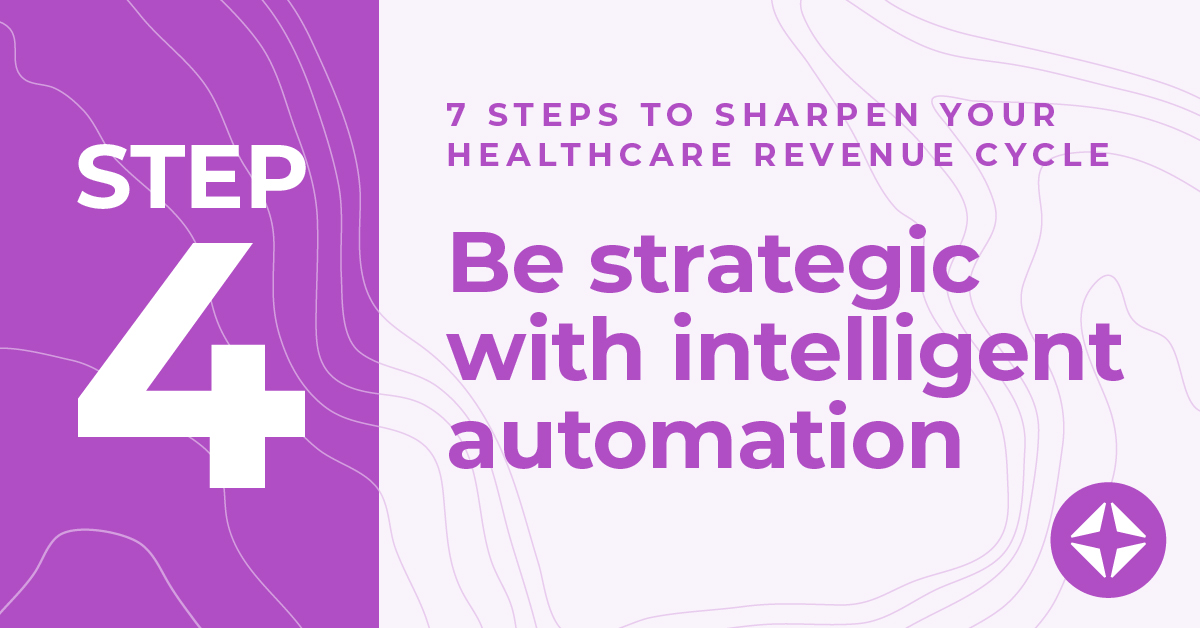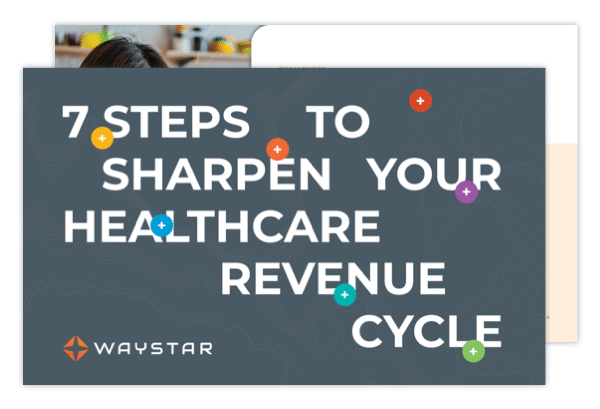
This is the fifth post in a new Waystar blog series: 7 steps to sharpen your healthcare revenue cycle.
Can’t wait for a new blog each week? Download the eBook to learn 7 steps for maximizing your healthcare RCM software.
Intelligent automation in healthcare has grown quickly in recent years. While staffing shortages and other priorities caused a brief pause in ramping up automation during the pandemic, today it’s back at the fore. In fact, a recent study shows that expanding intelligent automation is a top five priority for CFOs in 2023.
But as organizations put automation into place, it’s key to understand the distinction between basic and intelligent automation.
What is intelligent automation in healthcare?
Intelligent automation goes further than simply completing tasks without human intervention. Rather than one bot performing the same task repeatedly with no variation (basic automation), intelligent automation in healthcare performs those tasks but is also smart enough to know when to ask for help. Intelligent automation pulls humans into the process only at key junctures to make critical decisions that can drive better outcomes.
Put another way:
Basic automation in healthcare is static.
A bot performs the same tasks repeatedly with no change.
Intelligent automation in healthcare is dynamic.
A bot performs the same tasks repeatedly, but it also gathers data and improves workflows over time. Using that data, intelligent automation identifies when there’s an opportunity for a workflow or process to be improved, and it taps humans to make that call.
The benefits of intelligent automation in healthcare
Intelligent automation in healthcare has countless benefits, but the biggest are improved cash flow, reduced costs, and the ability for staff to work smarter, not harder. For most organizations, it’s working.
A survey on intelligent automation in healthcare released by Waystar and The Academy reflects its potential. Of leaders who adopted AI and RPA:
- 74% saw increased revenue capture
- 82% cited workforce cost reductions
- 91% reported improved revenue performance
But even knowing the power of intelligent automation in healthcare, where do you start?
If you can only start by only automating a few things, start with these three.
1. Coverage checks
Insurance verification — the process of confirming a patient’s insurance with the payer directly — is laborious and fraught with error. Checking every payer’s website to verify coverage is antiquated and time-consuming. By using intelligent automation in healthcare for this process, you can redirect staff efforts to other tasks and still verify every patient’s coverage and benefits.
If your process is already automated (as it is for most organizations today) verify that your technology includes all payers. In many instances, the process is in place, but the payers that are integrated into the process are limited.
Next, activate this workflow during the scheduling process to alert patients in real-time to coverage issues. Then, check again 1-3 days prior to a patient’s visit, and let them know if insurance cannot be verified. If needed, offer a counseling intervention with a financial advocate — something that will help both your patient experience and your denial rate.
2. Clinical documentation
Revenue cycle management (RCM) relies on codes that are:
- Generated by providers or staff
- Assigned based on reported services
At times, there’s a gap between the services performed and those that are documented. This variance leads to revenue leakage.
However, if you use automation for clinical documentation, you can close that gap. With the right technology, you can optimize your revenue lift while improving the accuracy of your reporting on behalf of patients.
3. Specific repetitive tasks
If it seems like your staff is always repeating the same functions, that’s because they are. RCM is transactional by nature.
Payers know and leverage this fact. They deploy technology to identify patterns, and then they downcode or deny claims — which is one big reason denials have skyrocketed in recent years.
For example, many organizations have seen a high number of 99215s being flagged and downcoded by payers. Often, those organizations can’t keep up with these aggressive payment challenges because manual solutions are not cost-effective.
But there is good news: you can leverage the same tools payers are using to improve outcomes for your organization. Robotic process automation (RPA), artificial intelligence (AI), and machine learning can help you with all sorts of repetitive tasks, including:
- Provider enrollment and credentialing
- Prior authorizations
- Denials and appeals
- Payment monitoring
- Bill payment
- Small-balance collection
- Secondary claims
Deployed properly, intelligent automation in healthcare can reduce human error and free up staff to address issues that require a human touch.
How to deploy intelligent automation for your organization
Although technology brings opportunity, consider its application within your organization in detail. Ask:
- Is the new technology streamlining work? Or will its introduction put a strain on staff without producing value?
- Are staff adequately trained in the new technology? If not, how quickly can you get them trained?
- Does your vendor truly view its customers as partners? Do they provide training opportunities and responsive customer support?
Implementing technology for the sake of automation won’t bring the results you need. Leveraging technology to change the way you work will.
Want to know more about optimizing your rev cycle?
- Read all the blogs in this series
- Watch the webinar with Dr. Elizabeth Woodcock
- Download the complete eBook







